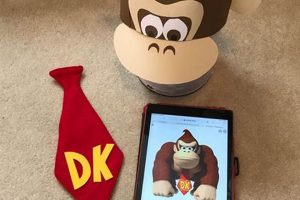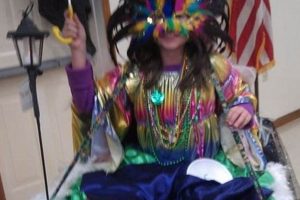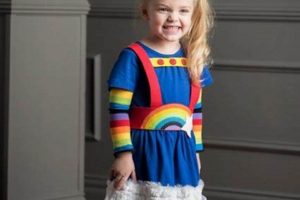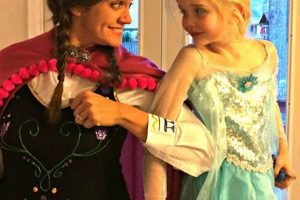Creating a Hagrid-inspired outfit using do-it-yourself methods involves assembling apparel and accessories that emulate the distinctive appearance of the character Hagrid from the Harry Potter series. This undertaking frequently includes crafting or modifying garments like a long, heavy coat, substantial trousers, and sturdy boots, often complemented by a wig and beard to replicate the character’s signature facial hair. Example projects range from simple adjustments to existing clothing items to elaborate construction of entire costume components.
The benefits of this approach include cost-effectiveness, personalization, and creative expression. Individuals can tailor the outfit to their specific size, preferences, and budget, resulting in a unique and potentially higher-quality result than mass-produced costumes. Historically, such costume creation has been a common practice for individuals participating in cosplay, attending themed events, or engaging in theatrical productions, offering an alternative to purchasing pre-made ensembles.
Subsequent sections will detail the specific elements required to assemble a convincing portrayal of the character, providing guidance on sourcing materials, modifying existing clothing, and constructing key accessories.
Hagrid Costume DIY
Achieving an accurate representation of the character requires careful attention to detail and a strategic approach to resourcefulness.
Tip 1: Coat Selection is Crucial: Begin with a long, brown coat, ideally made of a durable material like corduroy or wool. Thrift stores are excellent sources for affordable options. The coat’s length should extend to mid-calf or ankle for authenticity.
Tip 2: Prioritize Layering: The character’s attire consists of multiple layers. A simple brown shirt, perhaps with a slightly oversized fit, is a good starting point. Vests or additional shirts can be incorporated for added dimension.
Tip 3: Focus on the Trousers: Large, dark-colored trousers, preferably corduroy or moleskin, contribute to the overall bulky silhouette. Suspenders can enhance the visual effect.
Tip 4: Footwear Matters: Sturdy, dark brown or black boots are essential. Work boots or hiking boots are suitable choices, ensuring both accuracy and comfort.
Tip 5: Wig and Beard are Non-Negotiable: A high-quality wig and beard are critical for recognizable portrayal. Consider purchasing a set specifically designed for costume purposes or consulting theatrical supply stores.
Tip 6: Accessorize Intentionally: A large belt with a simple buckle adds a final touch. Consider a shoulder bag or satchel to complete the look.
Tip 7: Pay Attention to the Beard’s Grooming: The beard must be appropriately styled. Trim and shape the beard to reflect the character’s unkempt yet recognizable appearance.
Diligent planning and resourcefulness, along with focus on the aforementioned details, will help ensure a successful outcome in this undertaking.
The next section will explore specific material sourcing and construction techniques for more intricate costume elements.
1. Oversized coat
The oversized coat is a cornerstone element within the construction of a Hagrid-inspired costume. Its significance stems from its direct contribution to the character’s defining visual characteristic: a large, imposing physical presence. The coat, by virtue of its size and style, immediately communicates the character’s bulk and stature. Without a sufficiently large coat, other costume elements, such as the wig and beard, appear disproportionate and the overall effect is diminished. As an illustration, a standard-sized coat would fail to convey the intended impression, regardless of the accuracy of other components. The oversized nature of the coat is thus a critical causal factor in achieving an authentic likeness.
The selection of a suitable coat often involves sourcing vintage or thrifted items, or alternatively, altering existing garments to achieve the necessary volume. The chosen material typically emulates rough textiles like wool or corduroy to further enhance the character’s rustic appearance. The coat’s length is also a significant factor; it generally extends to mid-calf or ankle. The practical application of this understanding is evident in numerous examples of successful Hagrid interpretations, where the coat’s size and texture contribute significantly to the overall impression. Consider productions where costuming teams invest considerable effort to ensure the coat accurately reflects the character’s established design.
In summary, the oversized coat is not merely an accessory but a fundamental building block in the effort to recreate the character’s appearance. The challenge lies in finding or modifying a garment that meets the specific requirements of size, material, and style, ensuring it serves as the foundation upon which the rest of the costume is built. This understanding is vital for both professional costumers and individuals undertaking the project at home, as it directly impacts the costume’s visual impact and its ability to convey the character’s essence.
2. Wild, bushy beard
A wild, bushy beard represents an indispensable element of a successful Hagrid costume. The connection between a disheveled, voluminous beard and a recognizable portrayal is causal. Without a beard of appropriate size and untamed quality, the costume risks appearing incomplete or mischaracterized. Its presence, therefore, acts as a visual cue, instantly identifying the wearer as Hagrid. Consider stage productions and fan conventions; the most convincing portrayals invariably feature substantial facial hair. The absence or inadequacy of the beard consistently detracts from the authenticity of the overall presentation.
The process of creating or acquiring a suitable beard involves several approaches. Ready-made beards, frequently constructed from synthetic fibers, are widely available; however, achieving a naturalistic effect often necessitates styling and trimming. Alternatively, individuals can construct a beard from scratch using crepe hair or similar materials. The chosen method requires diligent attention to detail. Specifically, the beard’s color, texture, and overall shape must align with the established visual characteristics of the character. The use of theatrical adhesives ensures secure attachment while minimizing skin irritation. Examples in professional costuming reveal the meticulous labor dedicated to beard creation, including custom coloring and intricate layering techniques to replicate the character’s distinctive appearance.
In summary, the wild, bushy beard is not merely an accessory but a core component directly linked to the recognizability and impact of a Hagrid costume. The selection, styling, and secure application of the beard present unique challenges that must be overcome to achieve an authentic and convincing portrayal. Overlookin
g the importance of this element undermines the entire endeavor. The connection between the beard’s quality and the costume’s overall success remains critical.
3. Key prop
The inclusion of a specific prop elevates a self-constructed Hagrid costume beyond a mere collection of garments and accessories. The umbrella, in this context, serves as a distinctive and readily identifiable marker, immediately associating the wearer with the character from the Harry Potter series.
- Symbolism and Character Association
The umbrella functions as more than a mere weather shield; it symbolizes Hagrid’s inherent connection to magic, albeit often concealed or restricted. It represents a wand disguised, a subtle nod to his expulsion from Hogwarts. The presence of this prop reinforces the character’s backstory and adds depth to the portrayal. For example, an individual encountering the costumed figure carrying an umbrella immediately understands the reference, even without other immediately obvious costume components.
- Visual Distinctiveness
The umbrella, typically oversized and somewhat battered in appearance, provides a visually striking element. Its unique shape and characteristic wear instantly differentiate the Hagrid costume from other similar characters. Consider, for instance, the difference between a generic wizard costume and one that incorporates Hagrid’s specific umbrella: the latter is instantly recognizable due to this specific detail.
- Practical Considerations for Construction
Creating or acquiring a suitable umbrella presents specific challenges. A standard umbrella can be modified to appear more worn and oversized, perhaps by adding fabric patches or intentionally damaging the canopy. The handle can also be customized to resemble the character’s makeshift wand. Sourcing a vintage or antique umbrella offers an alternative route, potentially requiring less modification.
- Interactive Potential
The umbrella allows for a degree of interaction and role-playing. The costumed individual can mimic Hagrid’s characteristic gestures, such as tapping the umbrella or using it to subtly “cast spells.” This adds an element of playfulness and engagement, further enhancing the portrayal and inviting interaction from observers. The prop facilitates a more complete and believable character interpretation.
Integrating this particular prop contributes significantly to the overall success of constructing a Hagrid costume. The umbrella, beyond its functional purpose, serves as a key symbol, adding visual distinctiveness and enhancing interactive potential. Its careful selection or creation is a crucial step in achieving an accurate and compelling representation of the character.
4. Distressed, large boots
The selection of appropriate footwear is a critical consideration within the domain of a Hagrid-inspired costume. The character’s boots contribute significantly to the overall visual impression, conveying both practicality and a sense of ruggedness consistent with his outdoor lifestyle and physical stature. These boots serve not only as a functional element but also as a visual signal that immediately aligns the costume with the intended character.
- Establishing the Character’s Stature
Large boots inherently contribute to the character’s imposing physical presence. The exaggerated size, in comparison to typical footwear, amplifies the impression of mass and strength. For instance, standard-sized boots would diminish the intended effect, creating a visual incongruity that detracts from the character’s established proportions. The selection of oversized footwear, therefore, directly impacts the costume’s ability to convey the character’s stature.
- Reflecting a Practical and Rugged Lifestyle
The “distressed” quality suggests wear and tear, indicative of a character who spends considerable time outdoors and engages in physically demanding activities. Clean, pristine boots would contradict the established aesthetic, implying a degree of refinement inconsistent with Hagrid’s persona. Examples in film and published illustrations consistently depict the character wearing well-worn footwear, reinforcing the association between the boots’ condition and the character’s lifestyle.
- Sourcing and Modification Techniques
Acquiring suitable boots may involve purchasing work boots or hiking boots and intentionally distressing them through techniques such as scuffing, applying dirt, or using specialized weathering products. Thrift stores and surplus outlets are potential sources for affordable options that can be modified to achieve the desired appearance. The modification process necessitates careful attention to detail, ensuring that the resulting wear and tear appears authentic and not contrived.
- Impact on Overall Costume Authenticity
The choice of footwear significantly influences the overall impression of authenticity. Boots that are too modern, too clean, or inappropriately sized will detract from the costume’s credibility. Conversely, well-chosen and properly distressed boots contribute significantly to creating a convincing and immersive portrayal. Examining professional costuming examples reveals a consistent emphasis on footwear selection and modification, underscoring its importance in achieving an accurate representation.
The selection of distressed, large boots constitutes a crucial element in the creation of an effective Hagrid-inspired outfit. These boots contribute to establishing the character’s stature, reflecting a practical and rugged lifestyle, and significantly impacting the overall costume authenticity. Diligent attention to sourcing, modification, and detailing is necessary to ensure that the footwear aligns with the character’s established visual characteristics.
5. Voluminous trousers
Voluminous trousers are integral to the creation of a recognizable Hagrid costume. They directly contribute to the character’s signature silhouette, emphasizing a sense of size and physical presence.
- Silhouette Definition
The trousers’ voluminous cut helps to define the lower portion of Hagrid’s imposing figure. Fitted or traditionally tailored trousers would undermine the intended bulky appearance. The loose fit contributes to the overall visual weight and proportion, ensuring that the costume accurately reflects the character’s substantial build. Consider the effect of pairing an oversized coat with slim-fitting trousers; the resulting silhouette would be inconsistent with Hagrid’s established form.
- Material and Texture Consistency
The choice of material for the trousers complements the overall costume aesthetic. Corduroy, moleskin, or similarly textured fabrics enhance the rugged, practical impression. Lightweight or refined materials would appear incongruous. The fabric’s drape and weight further contribute to the trousers’ voluminous appearance. Selecting a material that drapes well and holds its shape is critical to maintaining the intended silhouette
throughout the costume’s wear. Examples of inappropriate fabric choices would include linen or silk, as they lack the necessary weight and texture. - Color Palette Adherence
The trousers typically adhere to a muted, earthy color palette, aligning with the overall costume’s tones. Dark browns, greens, or blacks are common choices. Bright or highly saturated colors would be inconsistent with the character’s established attire. The color choice reinforces the practical and unassuming nature of the character’s clothing. Observing film and theatrical productions reveals a consistent adherence to this muted color scheme, reinforcing its importance in achieving an authentic representation.
- Impact on Overall Costume Cohesion
The voluminous trousers, in conjunction with the other costume elements, contribute to a cohesive visual narrative. The trousers, coat, and boots work together to create a unified impression. The trousers, in essence, act as a foundation upon which the other elements are built. A disjunction between the trousers and other costume components would disrupt the overall aesthetic and diminish the costume’s effectiveness. The integration of voluminous trousers is, therefore, a vital step in constructing a convincing Hagrid-inspired outfit.
The selection and incorporation of voluminous trousers are fundamental for a successful Hagrid costume. The trousers’ silhouette, material consistency, and color palette contribute significantly to the character’s overall visual representation. Disregarding the importance of this element undermines the costume’s authenticity.
Frequently Asked Questions
This section addresses common inquiries regarding the construction of a Hagrid-inspired costume using do-it-yourself methods, offering clarification and practical guidance.
Question 1: What is the minimum acceptable budget for creating a convincing Hagrid costume?
The minimum budget varies significantly depending on the sourcing of materials and the complexity of the construction. Utilizing thrift stores and repurposing existing garments can minimize expenses. However, a budget below $50 may limit the ability to acquire essential elements such as a suitable coat and wig.
Question 2: What materials are most suitable for creating a realistic beard?
Crepe hair and yak hair are commonly employed for crafting realistic beards. Crepe hair offers affordability and versatility, while yak hair provides a more natural texture and appearance. The choice depends on the desired level of realism and the available budget.
Question 3: How can an oversized coat be realistically weathered to reflect the character’s attire?
Weathering techniques include applying diluted acrylic paints in earth tones, distressing the fabric with sandpaper, and strategically adding patches or darns. The objective is to create a subtle impression of wear and tear without compromising the garment’s integrity.
Question 4: What are the recommended sources for acquiring large boots suitable for the costume?
Work boot retailers, surplus stores, and online marketplaces are potential sources. The boots should be durable, dark-colored, and ideally feature a worn appearance. Consider purchasing used boots to reduce costs and enhance authenticity.
Question 5: Is it necessary to create a replica of the character’s wand-umbrella?
While not strictly essential, the inclusion of the wand-umbrella significantly enhances the costume’s recognizability. A standard umbrella can be modified to resemble the prop, involving techniques such as reshaping the handle and adding decorative elements.
Question 6: How can the costume be adapted for warmer climates?
Select lighter-weight fabrics for the coat and trousers. Consider omitting layers and prioritizing breathability. A modified wig with reduced hair density can also improve comfort in warm weather.
Creating an effective portrayal requires careful planning and attention to detail. Budget considerations, material selection, and modification techniques are all critical factors.
The following section provides additional tips for enhancing the impact of the completed costume.
Conclusion
This exploration of “hagrid costume diy” has highlighted the essential elements required for a successful portrayal, emphasizing the significance of key components such as the oversized coat, bushy beard, distinctive umbrella, distressed boots, and voluminous trousers. Emphasis was placed on the necessity of careful planning, resourceful sourcing, and meticulous execution to achieve an authentic visual representation.
The pursuit of constructing a convincing likeness presents both creative opportunities and technical challenges. Continued refinement of techniques and a commitment to detail will undoubtedly lead to increasingly accurate and compelling interpretations of this iconic character. The principles outlined offer a solid foundation for those undertaking this creative endeavor.







